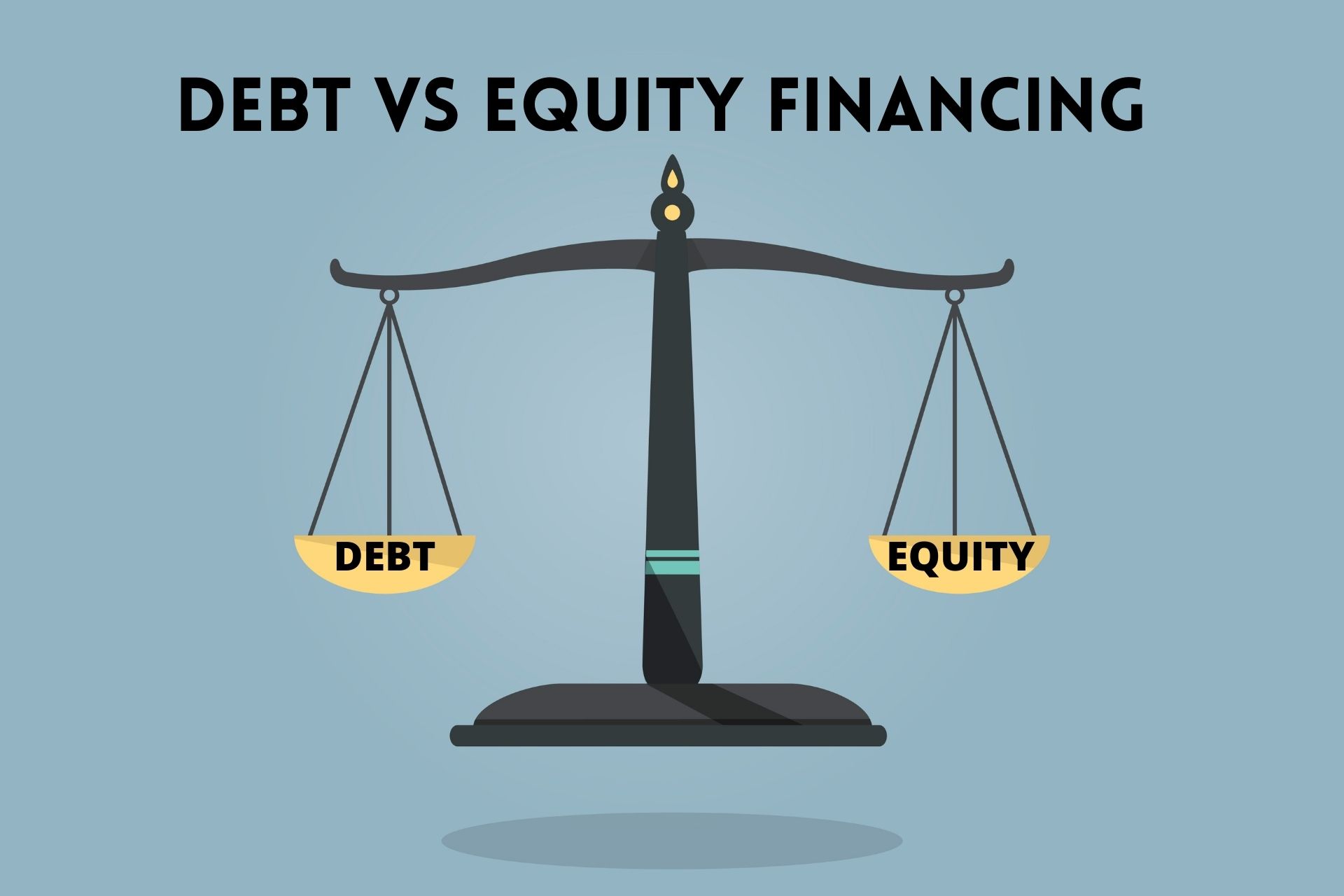Home>Finance>What Is The Difference Between Debt Financing And Equity Financing?


Finance
What Is The Difference Between Debt Financing And Equity Financing?
Modified: December 30, 2023
Learn the key distinctions between debt financing and equity financing in the realm of finance. Understand which option may be best for your business.
(Many of the links in this article redirect to a specific reviewed product. Your purchase of these products through affiliate links helps to generate commission for LiveWell, at no extra cost. Learn more)
Table of Contents
Introduction
When it comes to financing a business or a project, two commonly used options are debt financing and equity financing. These are two distinct methods that companies use to raise funds, each with its own set of advantages and considerations. Understanding the difference between debt financing and equity financing is crucial for entrepreneurs and business owners seeking capital to support their ventures.
Debt financing involves borrowing money from external sources, such as banks or financial institutions, with the promise of repayment over a specified period of time. On the other hand, equity financing involves raising funds by selling shares or ownership in the company to investors. While both options provide access to capital, they have distinct characteristics and implications for businesses.
In this article, we will delve into the nuances of debt financing and equity financing, highlighting the key differences between the two. We will also explore the advantages and disadvantages of each method, as well as the factors to consider when choosing between debt and equity financing.
Whether you are a business owner looking for ways to fund your operations or an investor seeking opportunities, understanding the different financing options available is essential to make informed decisions and maximize potential returns. Let’s dive into the world of debt financing and equity financing to gain a deeper understanding of these crucial concepts.
Debt Financing
Debt financing involves borrowing money from external sources, such as banks, financial institutions, or private lenders, to finance business operations or specific projects. It is a common method used by companies to obtain short-term or long-term funds.
When a company obtains debt financing, it enters into a contractual agreement with the lender, where it agrees to repay the borrowed amount, along with interest, within a specified period of time. The terms of the debt, including the interest rate, repayment schedule, and collateral requirements, are typically outlined in a loan agreement.
One of the primary advantages of debt financing is that the business retains full ownership and control over its operations. The lender does not have any ownership rights or involvement in the decision-making process of the company. This allows the business to maintain autonomy and execute its strategies without external interference.
Another benefit of debt financing is that the interest paid on the borrowed funds is tax-deductible, reducing the overall tax liability of the business. This can result in significant savings, especially for companies with high levels of debt.
However, there are also disadvantages associated with debt financing. The most obvious one is the obligation to repay the borrowed funds, regardless of the company’s profitability. Failure to meet the repayment obligations can lead to severe consequences, such as a damaged credit rating or even bankruptcy.
In addition, taking on excessive debt can increase the financial risk of the business. The interest payments on the debt can place a significant burden on cash flow, potentially limiting the company’s ability to invest in growth opportunities or address unforeseen challenges.
Furthermore, obtaining debt financing may require the business to provide collateral or personal guarantees, which serve as security for the lender. This adds an additional layer of risk for the business owner, as failure to meet repayment obligations can result in the loss of valuable assets or personal financial consequences.
Despite these challenges, debt financing remains a popular option for businesses due to its accessibility and lower cost compared to equity financing. It allows companies to leverage their assets and generate additional capital to fund their operations and pursue growth opportunities.
Equity Financing
Equity financing, unlike debt financing, involves raising funds by selling shares or ownership in a company to investors. In exchange for the capital infusion, investors become partial owners and shareholders of the business. Equity financing is commonly used by startups, high-growth companies, and businesses with limited access to traditional loans.
When a company seeks equity financing, it typically issues shares of stock and offers them to investors through various mechanisms such as initial public offerings (IPOs), private placements, or crowdfunding campaigns. The amount of equity offered to investors depends on the valuation of the company and the terms negotiated between the business and the investors.
One of the primary advantages of equity financing is that it does not require the business to make regular interest payments or repay the invested capital. Investors take on the risk of the investment and hope to earn returns through dividends and capital appreciation as the company grows and becomes profitable.
Equity financing can provide more flexibility for businesses in terms of cash flow management. Since there are no fixed repayment obligations, companies can utilize the funds raised for various purposes, such as expanding operations, research and development, or marketing initiatives without the pressure of immediate repayment.
In addition, equity financing allows businesses to tap into the expertise and networks of investors. Often, investors provide more than just capital; they bring industry knowledge, experience, and valuable connections that can help the company accelerate its growth trajectory.
However, there are drawbacks to equity financing as well. Selling ownership in the company means diluting the existing ownership and control. Major decisions may require the approval of shareholders, potentially leading to conflicts and a loss of autonomy for the business owner.
Another consideration is that equity financing can be more expensive in the long run compared to debt financing. While there are no interest payments or fixed obligations, the business must share its profits with shareholders through dividends or reinvesting in the company. Additionally, in the case of a successful exit, such as a sale or IPO, the initial investors may demand a significant return on their investment.
Equity financing is often perceived as a higher-risk option for investors, as there is a possibility of losing their entire investment if the company fails. This risk can make it more challenging for businesses to attract equity investors, particularly in early-stage or unproven ventures.
Despite these challenges, equity financing can be an attractive option for businesses with ambitious growth plans and the potential for significant returns. It provides the necessary capital to fuel expansion, access to industry expertise, and the opportunity to share the risks and rewards with investors.
Key Differences between Debt Financing and Equity Financing
Debt financing and equity financing are two fundamentally different approaches to raising capital for businesses. Understanding the key differences between these financing options is essential for entrepreneurs and business owners to make informed decisions about their funding strategies. Here are the primary distinctions between debt financing and equity financing:
- Ownership and Control: In debt financing, the business retains full ownership and control. The lender does not have any say in the decision-making process. In equity financing, investors become partial owners and have a say in major decisions through voting rights.
- Repayment: Debt financing requires regular repayment of the borrowed funds, typically with interest, over a specified period of time. Equity financing does not require repayment but instead offers returns through dividends or capital appreciation.
- Risk and Returns: Debt financing carries less risk for the business owner, as the repayment is fixed regardless of the company’s performance. In equity financing, the investors assume the risk and expect higher returns if the company performs well.
- Cost: Debt financing usually comes with interest payments that must be made on a regular basis, increasing the overall cost of financing. Equity financing does not involve interest payments but may require sharing profits or higher returns in the future.
- Access to Capital: Debt financing is generally more accessible, especially for established businesses with a track record of revenue and creditworthiness. Equity financing can be more challenging to obtain, often requiring compelling growth potential or an innovative business model.
- Flexibility: Debt financing provides more certainty in terms of repayment obligations and allows the business to plan its cash flow accordingly. Equity financing offers more flexibility, as there are no fixed repayment schedules or interest payments.
Overall, debt financing is a suitable option for businesses that prefer to maintain ownership and control and have predictable cash flow, while equity financing is more suitable for companies with high growth potential and a willingness to share ownership in exchange for capital and expertise.
It’s important for business owners to carefully evaluate the characteristics of their business, growth prospects, and their financial needs before deciding between debt and equity financing. Each option has its advantages and considerations, and the choice should align with the long-term goals and risk appetite of the company.
Factors to Consider When Choosing between Debt and Equity Financing
Choosing between debt financing and equity financing is a critical decision that can have long-term implications for a business. Various factors need to be taken into consideration to determine which option is most suitable for a particular company. Here are some key factors to consider when making the decision:
- Business Stage and Growth Potential: If a business is in its early stages or has high growth potential, equity financing may be more appropriate. Investors are often more willing to fund startups or companies with significant growth prospects as they seek higher returns on their investment.
- Capital Requirements: The amount of capital needed is an important consideration. Debt financing is often more suitable for smaller funding needs, while larger capital requirements may necessitate equity financing.
- Ownership and Control: Evaluate how much ownership and control you are willing to relinquish. If maintaining full control is important, debt financing may be preferable, as it does not involve sharing ownership with investors.
- Risk Tolerance: Consider your risk tolerance as a business owner. Debt financing carries less risk as repayment obligations are fixed, while equity financing entails sharing the risk with investors, who may demand a higher return if the business is successful.
- Collateral and Personal Guarantee: Debt financing often requires collateral or personal guarantees, which can put your business assets or personal finances at risk. Evaluate your willingness to provide collateral and the potential consequences of defaulting on the loan.
- Interest Rates and Costs: Compare the interest rates, fees, and costs associated with debt financing. Ensure that the cost of borrowing is reasonable and manageable for your business’s financial health.
- Tax Implications: Consider the tax implications of both options. Interest payments on debt financing are usually tax-deductible, which can provide tax benefits. Equity financing may have different tax implications, especially when it comes to dividends and capital gains.
- Investor Relationships: Assess the potential value that equity investors can bring in terms of industry knowledge, networks, and mentorship. Consider how well your goals align with those of potential investors and the dynamics of the relationship.
- Long-Term Vision: Consider your long-term goals for the business. Debt financing may be suitable for short-term needs, while equity financing can provide a longer runway for growth and expansion.
These factors should be taken into account when deciding between debt financing and equity financing. It may also be beneficial to consult with financial advisors or experts who can provide guidance based on your specific business circumstances.
Ultimately, understanding your business’s unique needs, growth trajectory, risk tolerance, and financial capabilities will help you make an informed decision that aligns with your long-term goals and maximizes the potential for success.
Advantages and Disadvantages of Debt Financing
Debt financing offers several advantages and disadvantages that businesses need to carefully consider before deciding to pursue this funding method. Understanding the pros and cons of debt financing will help entrepreneurs make informed decisions based on their specific needs and circumstances. Here are some key advantages and disadvantages of debt financing:
Advantages:
- Retained Ownership and Control: With debt financing, businesses retain full ownership and control. The lender does not have any say in the decision-making process or operations of the company.
- Fixed Repayment Obligations: Debt financing involves regular repayment of the loan amount with interest over a predetermined period. This fixed repayment schedule allows businesses to plan their cash flow and make accurate financial projections.
- Tax Deductible Interest: The interest paid on loans is often tax-deductible, reducing the overall tax liability for the business. This can result in significant cost savings, especially for companies with high levels of debt.
- Availability and Accessibility: Debt financing is generally more accessible than equity financing, especially for established businesses with a track record of revenue and creditworthiness. Banks, financial institutions, and private lenders offer a range of loan options tailored to different business needs and circumstances.
- Lower Long-Term Cost: Compared to equity financing, the cost of debt financing is often lower in the long run. Although interest payments need to be made, businesses can benefit from lower overall financing costs due to the fixed repayment schedule.
Disadvantages:
- Obligation to Repay: The primary disadvantage of debt financing is the obligation to repay the borrowed funds, regardless of the company’s profitability. Failure to meet repayment obligations can result in severe consequences such as damaged credit ratings or legal action against the business.
- Increased Financial Risk: Taking on excessive debt can increase the financial risk for the business. High interest payments can strain cash flow, limiting the company’s ability to invest in growth opportunities or address unforeseen challenges.
- Collateral and Personal Guarantee: In many cases, lenders may require collateral or personal guarantees to secure the loan. This puts business assets or personal finances at risk in the event of default.
- Financial Covenants and Restrictions: Lenders often impose financial covenants and restrictions on businesses, such as maintaining a certain debt-to-equity ratio or submitting regular financial statements. Non-compliance with these requirements can have serious consequences, such as acceleration of loan repayment or additional fees.
- Limited Investor Participation: Debt financing does not provide the opportunity for investors to participate in the future success of the business. Investors in debt financing are primarily concerned with receiving their principal and interest payments, without benefiting from the company’s potential growth or profitability.
Business owners should carefully assess these advantages and disadvantages to determine if debt financing aligns with their specific needs, risk appetite, and long-term financial goals. It is crucial to evaluate the company’s borrowing capacity, cash flow projections, and ability to meet repayment obligations before taking on debt.
Advantages and Disadvantages of Equity Financing
Equity financing offers distinct advantages and disadvantages that businesses should consider when deciding on their funding strategy. Understanding the pros and cons of equity financing will help entrepreneurs make informed decisions based on their specific needs and circumstances. Here are some key advantages and disadvantages of equity financing:
Advantages:
- No Repayment Obligations: Unlike debt financing, equity financing does not require regular repayment of capital or interest. Businesses are not burdened with fixed repayment schedules, which provides more flexibility in managing cash flow and focusing on long-term growth.
- Shared Risk: With equity financing, investors share the risk of the investment. In the event of business failure, the financial burden is dispersed among the investors, reducing the potential impact on the business owner’s personal assets.
- Access to Expertise and Networks: Equity investors often bring more than just financial capital to the table. They can contribute industry knowledge, experience, and networks, providing valuable guidance and connections that can help the business grow and succeed.
- Potential for Higher Returns: Equity investors participate in the future success and growth of the company. If the business performs well, investors can benefit from dividends and capital appreciation, potentially earning higher returns on their investment compared to fixed interest rates in debt financing.
- Long-Term Funding: Equity financing can provide a longer runway for businesses, especially startups or companies with ambitious growth plans. It offers the opportunity to secure substantial funding that can support expansion, research and development, and other strategic initiatives.
Disadvantages:
- Loss of Ownership and Control: The main disadvantage of equity financing is the loss of ownership and control. Shareholders have the right to influence decision-making processes and can potentially dilute the founder’s stake in the company.
- Higher Cost of Capital: While equity financing does not involve fixed interest payments, business owners need to consider the long-term cost of providing dividends or higher returns to investors. Over time, the cost of equity financing can be higher compared to debt financing.
- Challenging to Attract Investors: Attracting equity investors, especially in early-stage or unproven ventures, can be challenging. Investors often require strong growth potential and high confidence in the business model, which can limit the pool of potential investors.
- Complex Legal and Regulatory Requirements: Equity financing can involve complex legal and regulatory requirements, especially in the case of an initial public offering (IPO). Businesses need to comply with securities laws, disclosure requirements, and other regulations to offer shares to the public.
- Loss of Confidentiality: Equity financing often requires sharing detailed business information with investors, which may include sensitive data or trade secrets. This can compromise confidentiality and potentially impact competitive advantage.
Business owners should carefully evaluate these advantages and disadvantages to determine if equity financing aligns with their specific needs, long-term vision, and risk appetite. It is crucial to assess the potential dilution of ownership, the expected cost of providing returns to investors, and the compatibility between the business and potential investors before pursuing equity financing.
Conclusion
Choosing between debt financing and equity financing is a momentous decision that can significantly impact the financial health and future prospects of a business. Both financing options have distinct advantages and disadvantages, making it crucial for entrepreneurs and business owners to evaluate their specific needs, risk tolerance, and growth potential.
Debt financing provides businesses with access to capital while allowing them to retain ownership and control over their operations. It offers the benefit of fixed repayment obligations and tax-deductible interest payments. However, it also carries the risk of repayment, potential financial strain, collateral requirements, and limitations on investor participation.
Equity financing, on the other hand, allows businesses to raise funds by selling ownership in the company to investors. It offers flexibility in terms of repayment, shared risk, access to expertise and networks, and potential long-term funding. However, it involves the dilution of ownership and control, higher long-term costs, challenges in attracting investors, legal and regulatory complexities, and potential loss of confidentiality.
To make an informed decision, business owners should consider factors such as the stage of their business, capital requirements, risk tolerance, ownership preferences, cost of capital, and long-term vision. It is essential to assess the suitability of debt financing or equity financing based on these factors and align the funding strategy with the business’s goals and growth trajectory.
Moreover, seeking advice from financial advisors, industry experts, or experienced professionals can provide valuable insights and guidance in determining the optimal financing approach. By carefully weighing the pros and cons of debt financing and equity financing, businesses can secure the necessary capital and position themselves for success.
Ultimately, there is no one-size-fits-all solution, and the choice between debt financing and equity financing should be based on a thorough assessment of the unique needs, circumstances, and goals of the business. Whether it’s the structured repayment of debt or the potential for growth through equity, the right financing choice can set a firm foundation for businesses to thrive and achieve their objectives.














